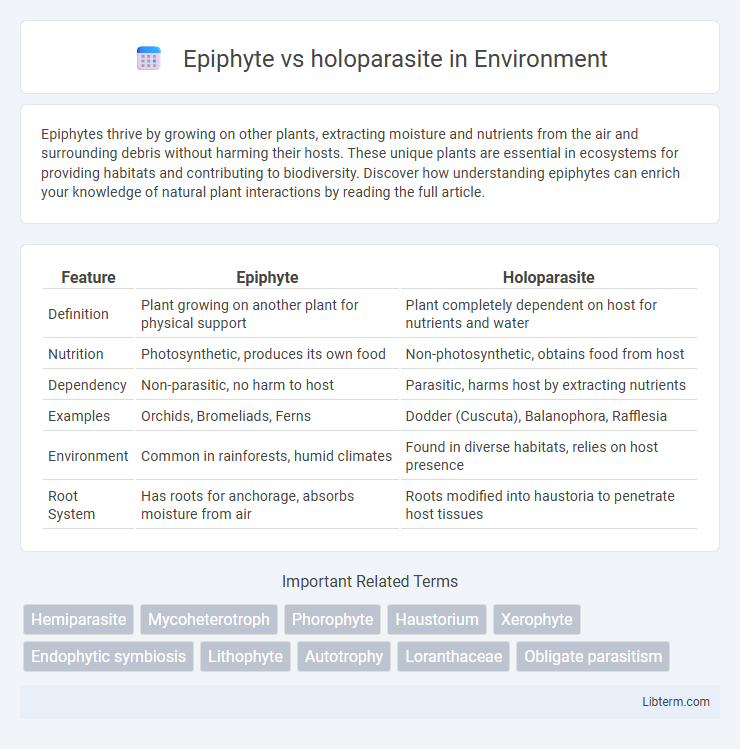Epiphytes thrive by growing on other plants, extracting moisture and nutrients from the air and surrounding debris without harming their hosts. These unique plants are essential in ecosystems for providing habitats and contributing to biodiversity. Discover how understanding epiphytes can enrich your knowledge of natural plant interactions by reading the full article.
Table of Comparison
| Feature | Epiphyte | Holoparasite |
|---|---|---|
| Definition | Plant growing on another plant for physical support | Plant completely dependent on host for nutrients and water |
| Nutrition | Photosynthetic, produces its own food | Non-photosynthetic, obtains food from host |
| Dependency | Non-parasitic, no harm to host | Parasitic, harms host by extracting nutrients |
| Examples | Orchids, Bromeliads, Ferns | Dodder (Cuscuta), Balanophora, Rafflesia |
| Environment | Common in rainforests, humid climates | Found in diverse habitats, relies on host presence |
| Root System | Has roots for anchorage, absorbs moisture from air | Roots modified into haustoria to penetrate host tissues |
Understanding Epiphytes: Definition and Characteristics
Epiphytes are plants that grow non-parasitically on other plants, primarily using them for physical support while obtaining moisture and nutrients from the air and surrounding debris. Unlike holoparasites, which depend entirely on their host plants for sustenance by extracting water and nutrients through specialized structures called haustoria, epiphytes perform photosynthesis independently and do not harm their hosts. Common examples of epiphytes include orchids, ferns, and bromeliads, which thrive in humid environments such as tropical rainforests.
Holoparasites Explained: Key Features and Adaptations
Holoparasites are non-photosynthetic plants that derive all nutrients and water from their host plants through specialized haustoria, lacking chlorophyll entirely. These plants exhibit extreme adaptations such as the reduction or complete absence of leaves and roots, relying solely on host vascular tissues for survival. Species like Rafflesia and Orobanche demonstrate these adaptations, allowing holoparasites to thrive in diverse ecosystems by exploiting their hosts' resources.
Major Differences Between Epiphytes and Holoparasites
Epiphytes are plants that grow harmlessly upon other plants to access sunlight and air without extracting nutrients, whereas holoparasites are fully parasitic plants that derive all their nutrients from the host, lacking chlorophyll and the ability to photosynthesize. Epiphytes obtain water and nutrients from rain, air, and debris around them, while holoparasites form haustoria to penetrate host tissues for nutrient absorption. The ecological impact of epiphytes is generally neutral or beneficial in providing habitat, unlike holoparasites, which often weaken or kill their host plants.
Ecological Roles: Epiphytes vs. Holoparasites
Epiphytes play a crucial ecological role by enhancing biodiversity and providing habitat for various species without extracting nutrients from their host plants, as they primarily obtain moisture and nutrients from the air and rain. Holoparasites, in contrast, rely entirely on their host plants for water and nutrients, often compromising host health and altering plant community dynamics. The coexistence of epiphytes and holoparasites influences ecosystem complexity, where epiphytes support structural diversity and holoparasites impact nutrient cycling and plant population control.
Nutrient Acquisition Strategies in Epiphytes
Epiphytes acquire nutrients primarily through specialized structures such as trichomes and absorptive roots that capture moisture and organic debris from the air and surrounding environment, unlike holoparasites that extract nutrients directly from host plants via haustoria. Epiphytes often inhabit tree branches or surfaces where soil is absent, relying on atmospheric inputs and symbiotic relationships with fungi to supplement limited nutrient availability. This adaptation allows epiphytes to thrive without soil contact, contrasting with holoparasitic plants that depend entirely on their hosts for water, carbohydrates, and minerals.
How Holoparasites Obtain Nutrients from Hosts
Holoparasites obtain nutrients from their host plants by attaching to the host's vascular system using specialized structures called haustoria, which penetrate the host tissues to extract water, minerals, and organic compounds directly. Unlike epiphytes, which gather nutrients and water from the air and rain, holoparasites lack chlorophyll and rely entirely on their hosts for sustenance. This parasitic adaptation allows holoparasites, such as dodder (Cuscuta spp.) and broomrape (Orobanche spp.), to survive without performing photosynthesis.
Common Examples of Epiphytes and Holoparasites
Common examples of epiphytes include orchids, bromeliads, and ferns, which thrive on the surface of trees without extracting nutrients directly from their hosts. Holoparasites like dodder (Cuscuta spp.), broomrape (Orobanche spp.), and Indian paintbrush (Castilleja spp.) depend entirely on their host plants for water and nutrients, lacking chlorophyll for photosynthesis. Epiphytes contribute to biodiversity in rainforest canopies, while holoparasites impact agricultural productivity by parasitizing crops.
Evolutionary Significance of Epiphytes and Holoparasites
Epiphytes and holoparasites exhibit distinct evolutionary adaptations that highlight divergent survival strategies; epiphytes evolved to maximize light capture and nutrient acquisition without soil dependence, enabling colonization of tree canopies in dense forests. Holoparasites underwent genomic reduction and loss of photosynthetic ability, relying entirely on host plants for nutrients, representing an extreme form of parasitism and niche specialization. Both adaptations illustrate evolutionary innovations promoting species diversification and ecosystem complexity in plant communities.
Epiphyte and Holoparasite Distribution in Ecosystems
Epiphytes predominantly thrive in tropical and subtropical rainforests, where high humidity and dense canopy structures support their growth on host plants without extracting nutrients. Holoparasites, in contrast, are distributed across diverse ecosystems including temperate forests, grasslands, and deserts, relying entirely on their host plants for nutrients through haustorial connections. The ecological roles of epiphytes contribute to habitat complexity and biodiversity, while holoparasites influence host population dynamics and nutrient cycling within their respective environments.
Impacts on Host Plants and Environmental Interactions
Epiphytes grow on host plants without extracting nutrients, generally causing minimal harm while contributing to biodiversity and microhabitat complexity. In contrast, holoparasites fully depend on host plants for water, nutrients, and carbon, often leading to reduced host vigor, growth, and reproductive success. These differing interactions influence ecosystem dynamics, where epiphytes enhance structural diversity and holoparasites can regulate host population and promote species turnover.
Epiphyte Infographic

 libterm.com
libterm.com